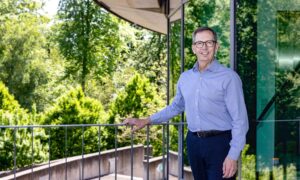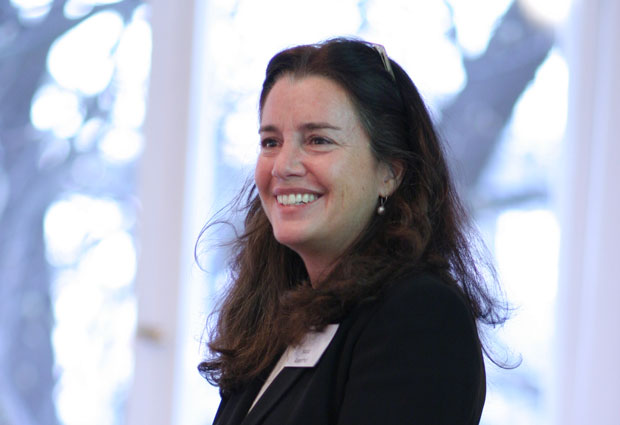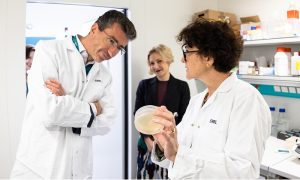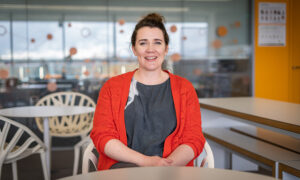
Fallingwater filled with mice
In EMBL Rome's 20th anniversary year, Nadia Rosenthal, Head of EMBL Rome 2001–2012 (initially known as the EMBL Mouse Biology Programme; later as EMBL Monterotondo), describes how she built EMBL Rome’s mouse house

When I first came to Monterotondo in 2000 I was interviewing alongside a group of prominent scientists. All the hopefuls had to present our proposals in front of each other, so it was pretty stressful. I’ll never forget the moment later that evening when Fotis Kafatos, then EMBL Director General, took me aside and said, “You got the job and you have twenty-four hours to make a decision whether you take it!”
At that time, the site in Monterotondo had intermittent internet and only 12 staff members, including all the administrators. The European Mutant Mouse Archive (EMMA) was next door, and EMBL’s mice were kept in a room rented at EMMA. The first few years were pretty tough, with a tight budget and no facilities of our own for doing mouse biology, so we had to make do. I knew a lot of people at The Jackson Laboratory in the US, where I now work, who used Thoren, a company in Pennsylvania, to develop individually ventilated mouse cages. I ordered 25 of those cages, and that meant we could use our laboratories – which had not been set up with any special air-handling system – to do work on mouse biology.
All of that was challenging, especially when I was trying to recruit new group leaders, so I really had to use my powers of persuasion to get several fantastic people to work there. One of the early people we hired was Cornelius Gross, now Deputy Head of EMBL Rome, and that was just the first of a spectacular run of scientists. Another was José Gonzales, whom I’d worked with at Harvard, who joined us to help set up the mouse house.
I told Emilio that I wanted to build something like Frank Lloyd Wright’s Fallingwater and fill it with mice
When I came for my interview, I was shown plans for a new mouse house that would be added to the existing building. Later I was told that we couldn’t use that design because the renovations would cost too much money, and it would be better to start from scratch. But when I spoke to the site manager, Emilio Mattoccia, who was hired by the Italian National Research Council (CNR) to run the whole campus, he said the Town had decided that no further building could happen on site, because we were in the floodplain of the Tiber and there were also concerns over seismic activity.
By that point, I couldn’t see how we were going to have a mouse facility and a mouse biology programme if we couldn’t build a mouse house! So I had to get creative.
One night, as I was lying awake wondering what I was going to do, I started thinking about how the site was configured. Our research building had a depressed loading bay with a ramp to make the basement accessible to delivery vans. It suddenly occurred to me that we could cantilever the facility out over the loading bay, rather than pour a new foundation. The next day I told Emilio that I wanted to build something like Frank Lloyd Wright’s Fallingwater over the back loading bay and fill it with mice.
Emilio thought this was very clever, and we started to work out how many posts we would need to hold the whole thing up. As long as the posts were far enough apart, he discovered, it would not be considered a new construction by the Town. So we designed the entire mouse house to be an extension of the existing facility, not exceeding the loading bay perimeter.
Then Emilio’s genius came in. He found a company in Parma that made prefabricated operating theatres for hospitals, with constant temperature, pressure, and humidity, which is exactly what you need for a mouse house. It was like Lego: we ordered these units brought down on big trucks and clicked them together with a shell around them, with all the machinery to handle the air above them. That meant the whole construction could be approved by the Town as a request for new equipment, and we were able to finish the construction of our mouse house for under €3 million.
I feel very proud that we made it work
The new facility was up and running by 2004 and as far as I know it’s never broken down. I feel very proud that we made it work. After that, I began lobbying hard to make the site in Monterotondo a new EMBL Unit, which was soon made official. We were also very successful in securing EU Framework Programme grants, which really helped to get us established.
In the end, the atmosphere there – people tell me – was similar to the early days in Heidelberg. We really had a sense of being a band of brothers, and of proving ourselves to the other EMBL sites, when at first we felt like we were just the little brothers who were rather ragged and had no shoes. By the time I left in 2012, our mouse house was full and our staff of 80 scientists included a healthy number of students and postdocs. We had an international network of collaborators and a world-class reputation in mouse-based biomedical research.
EMBL Rome continues to play a vital role in EMBL’s research on mammalian genetics – a role that’s likely to become even more important in future. For myself, I have great memories of my time there, and I still believe the EMBL model for running a scientific institute is the best I’ve ever experienced.
With thanks to EMBL Archivist Anne-Flore Laloë, who carried out the oral history interview on which this text is based.


